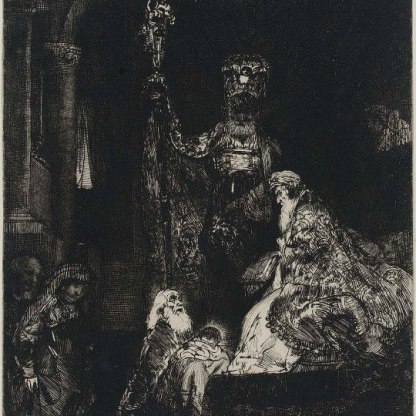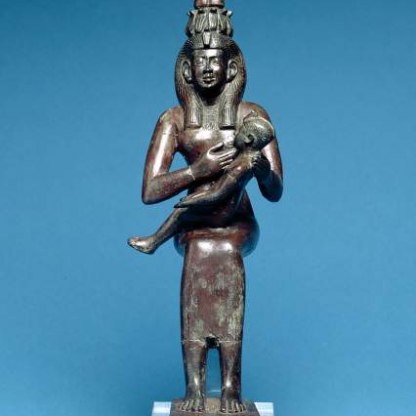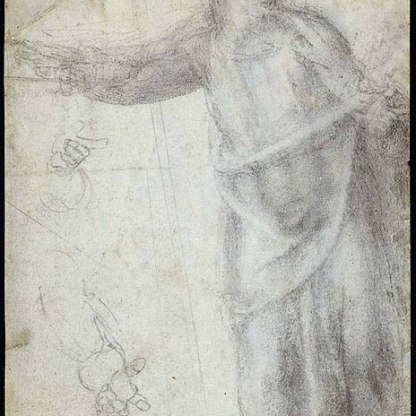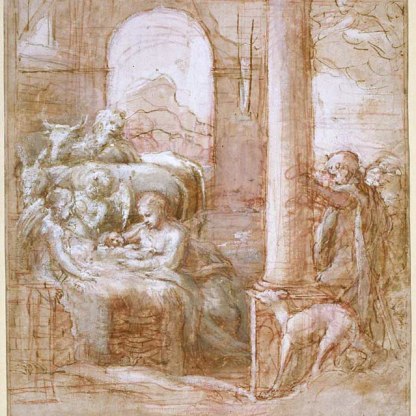Leaf from a Choir Book
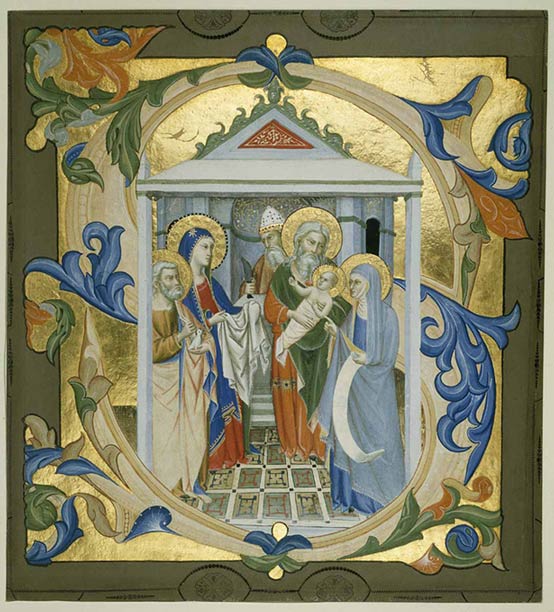
Historiated initial S, with the Presentation in the Temple
Whilst discussing the life and work of the painter-monk Lorenzo Monaco, Giorgio Vasari, the fifteenth-century writer on art, praises twenty choir books produced in the Florentine monastery of Santa Maria degli Angeli:
'I, who have seen them many times, am lost in astonishment that they should have been executed with such good design and with so much diligence at a time when all the arts of design were little better than lost ...'
He singles out for particular praise a scribe, Don Jacopo, and an illuminator, Don Silvestro, whose right hands were venerated as relics in the monastery after their deaths. The illumination here is thought to be the work of Don Silvestro’s revered fingers.
Choir books needed to be big, so that a single copy could be viewed by a group of singers. Large pages provided room for large pictures, and many finely illuminated choir books were cut up by art dealers and collectors in the nineteenth century. This painting is taken from the second volume of the series that had so impressed Vasari.
Easy to overlook, as it curls around the detailed central image, sprouting blue, green and gold foliage, is a large letter S. This is the start of a passage beginning at Psalm 47, 9: 'Suscepimus Deus', – 'We accept, O God'– which was used as the Introitus (the opening hymn)for mass on 2 February, the feast day of the Purification of the Virgin.
The subject of the picture embraced by the letter is appropriate to the feast, combining as it does the Purification with the Circumcision of Christ and his Presentation in the Temple.
In the background a priest stands holding a knife, the instrument of the Circumcision. As the first time that Christ shed blood, this was sometimes interpreted as the first act of his Passion, a prelude to the Crucifixion. It was also the occasion on which he was officially given the name of Jesus. Sometimes the Circumcision is shown as an event on its own. We see it in a full-page illumination from a c.1500 French Book of Hours in the Fitzwilliam, right [MS.131.f.156], painted in the atelier of the celebrated court painter Jean Bourdichon.
In Don Silvestro's painting, the knife-wielding priest is the only character not distinguished by a bright gold halo. At the left stands Joseph, holding two turtles doves, sacrificial offerings to mark the Purification of Mary, forty days after giving birth. The law of the Old Testament (Leviticus 12, 6–8) stated that the offering should consist of 'a lamb in its first year, and a young pigeon and a turtledove ... if she cannot afford a sheep, she shall take two turtle doves or pigeons'. The two birds therefore suggest the poverty of the Holy Family. Mary, in her customary ultramarine cloak with a bright golden star upon the hood, holds up a swaddling cloth.
The child himself has been taken from his mother by a richly bearded old man. This is Simeon, the aged prophet, who was among the first to recognise Christ as the Messiah. At Luke, 2, 32 he describes the newborn as 'a light to lighten the Gentiles, and the glory of thy people Israel'. Beside Simeon, holding a blank scroll, is Anna, the aged prophetess who also acknowledged the child’s divinity.
It is a beautifully executed painting, as fine as Vasari’s praise would lead one to expect. The symmetrical composition is simple but effective, and evokes a sense of solemn ceremonial. Particularly striking is the modelling of the faces, with soft areas of shading defining the features of the protagonists. Don Silvestro has been highly praised for the lavishness of his painted fabrics. Here, however, where humility and poverty are so central to the story, these are more subdued. Poverty, obedience and chastity, all of which virtues are celebrated here, are particularly appropriate themes for a painter who was also a monk.
Another cutting in the Fitzwilliam comes from the same volume and is also the work of Don Silvestro, left [MS.5-1979]. It shows Pope St Clement I, the third person to succeed to the papacy after St Peter, whose feast day is celebrated on 23 November.
Themes and periods
Data from our collections database
PHYSICAL DESCRIPTION: Parchment, initial aprox. 300 x 270 mm, mounted on cardboard. CONTENTS: The initial S, pasted on cardboard, would have opened the Introit to the Mass for the Purification of the Virgin (2 February), Suscepimus, Deus, misericordiam in medio templi tui. DECORATION: Historiated initial in graded blue, orange, pale yellow and liquid gold with acanthus extensions on a ground of gold leaf: [S] Presentation in the Temple with Simeon and Anna holding the infant Christ on the right, Mary and Joseph on the left, and a mitred priest behind holding the knife for Christ’s circumcision.
The initial belonged to a choir book made for the Camaldolese Monastery of Santa Maria degli Angeli in Florence: Corale 2 (Gradual), fol. 42; excised during the Napoleonic campaigns, 1797-1809; thereafter: possibly the property of William Young Ottley (1771-1836) (Freuler 1997, 353); Francis Douce (1757-1834), a note attached to the back of the mount, attributing the illumination to Don Silvestro, is believed to be in his hand; Sir Samuel Meyrick (1783-1848); acquired before 1886 by Charles Brinsley Marlay (1831-1912); his bequest, 1912.
Acquisition and important dates
- Method of acquisition: Bequeathed
- Dates: 1912
Dating
Maker(s)
- Gherarducci, Don Silvestro dei Artist
- Canzoni, Maestro delle Artist
- Rosselli, Niccolo Artist
- Francesco di Ser Cenni, Cenni di Artist
Place(s) associated
- Florence
Materials used in production
Read more about this recordStories, Contexts and Themes
Other highlight objects you might like
Suggested Curating Cambridge products
Sign up to our emails
Be the first to hear about our news, exhibitions, events and more…
